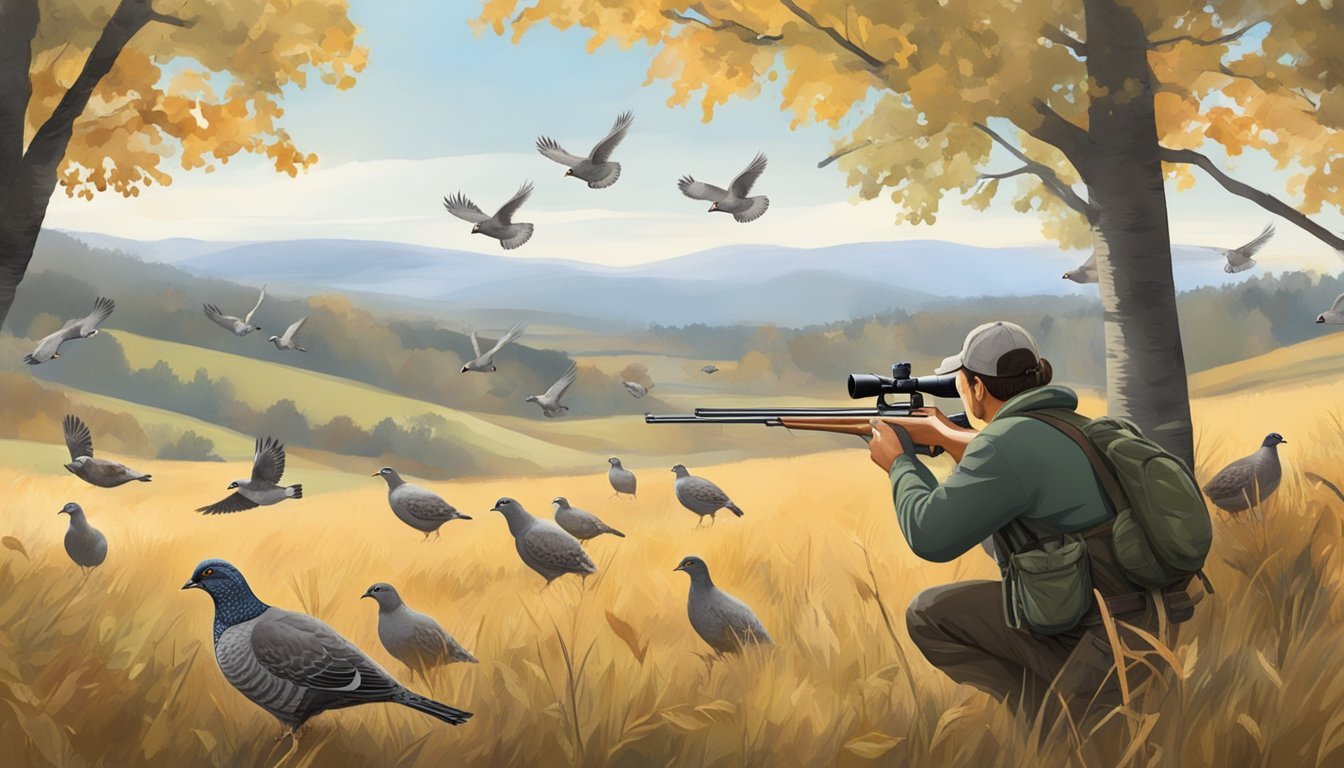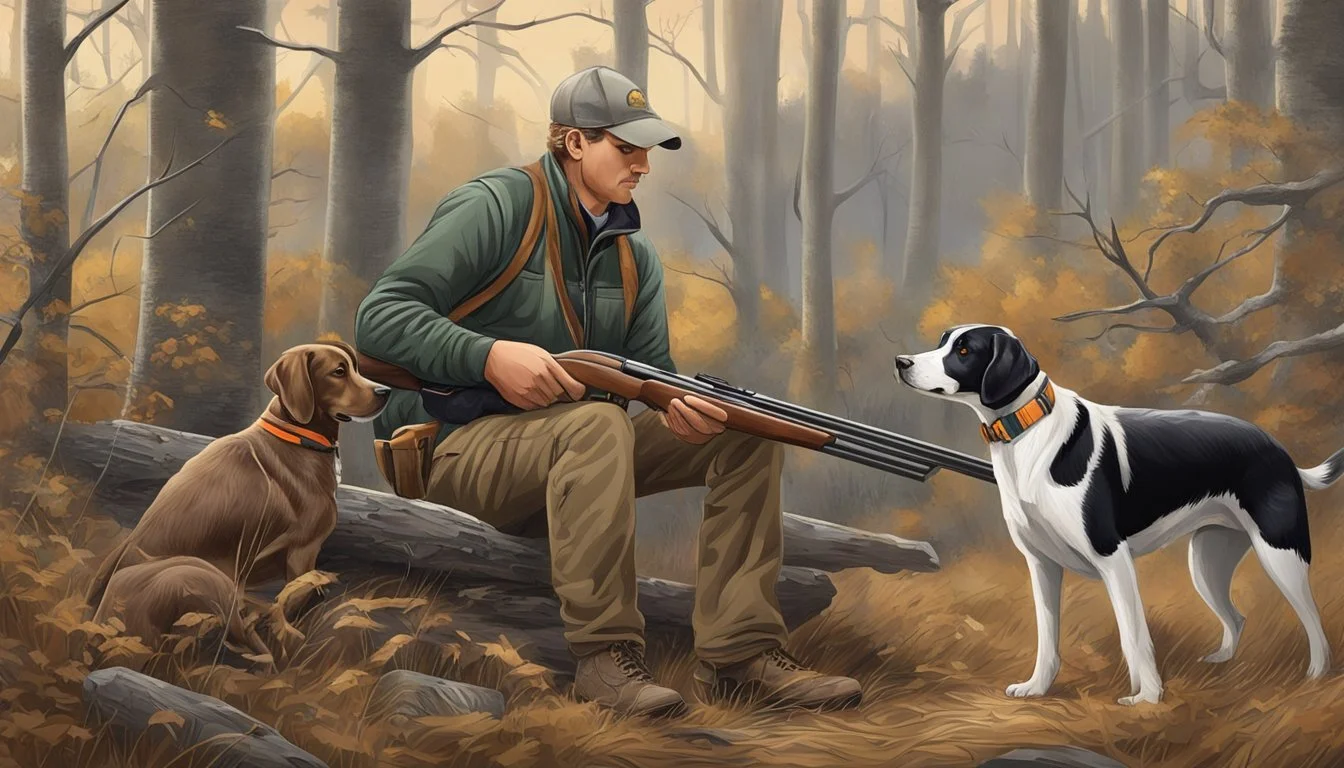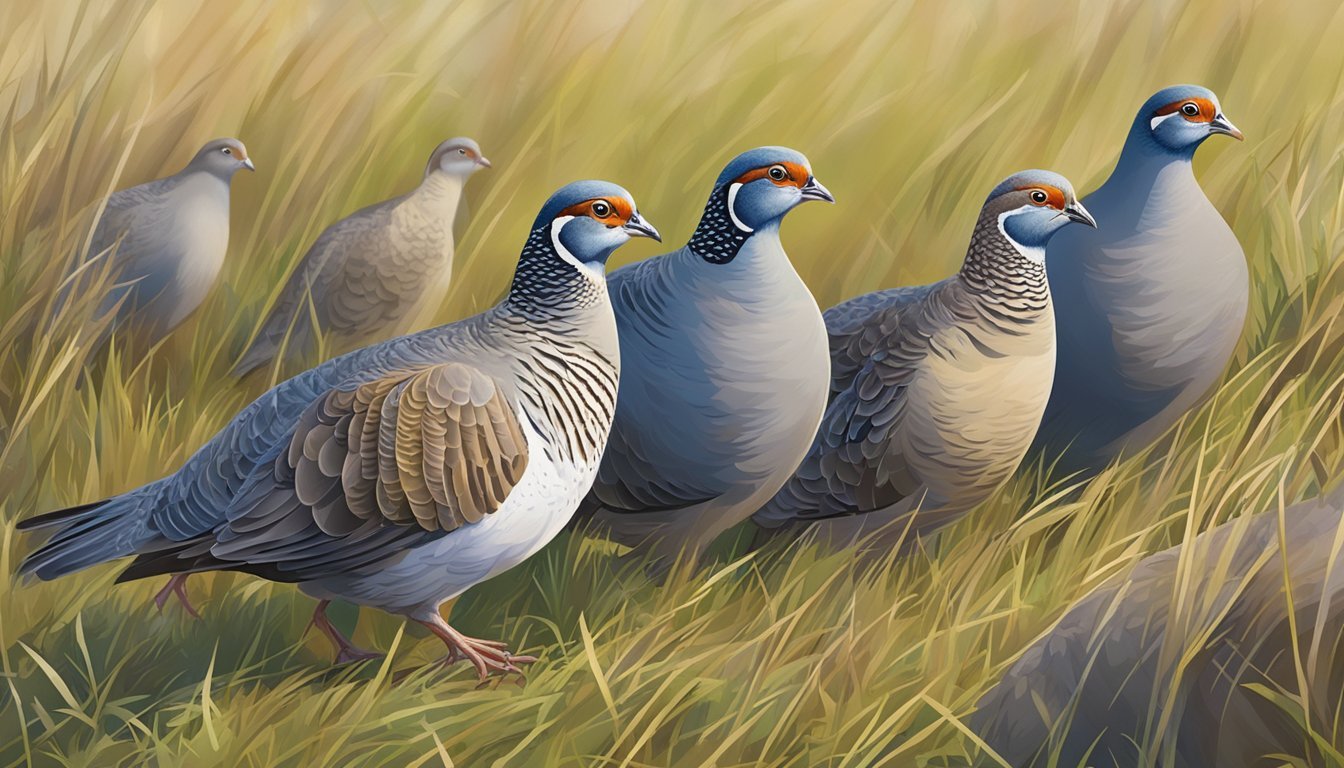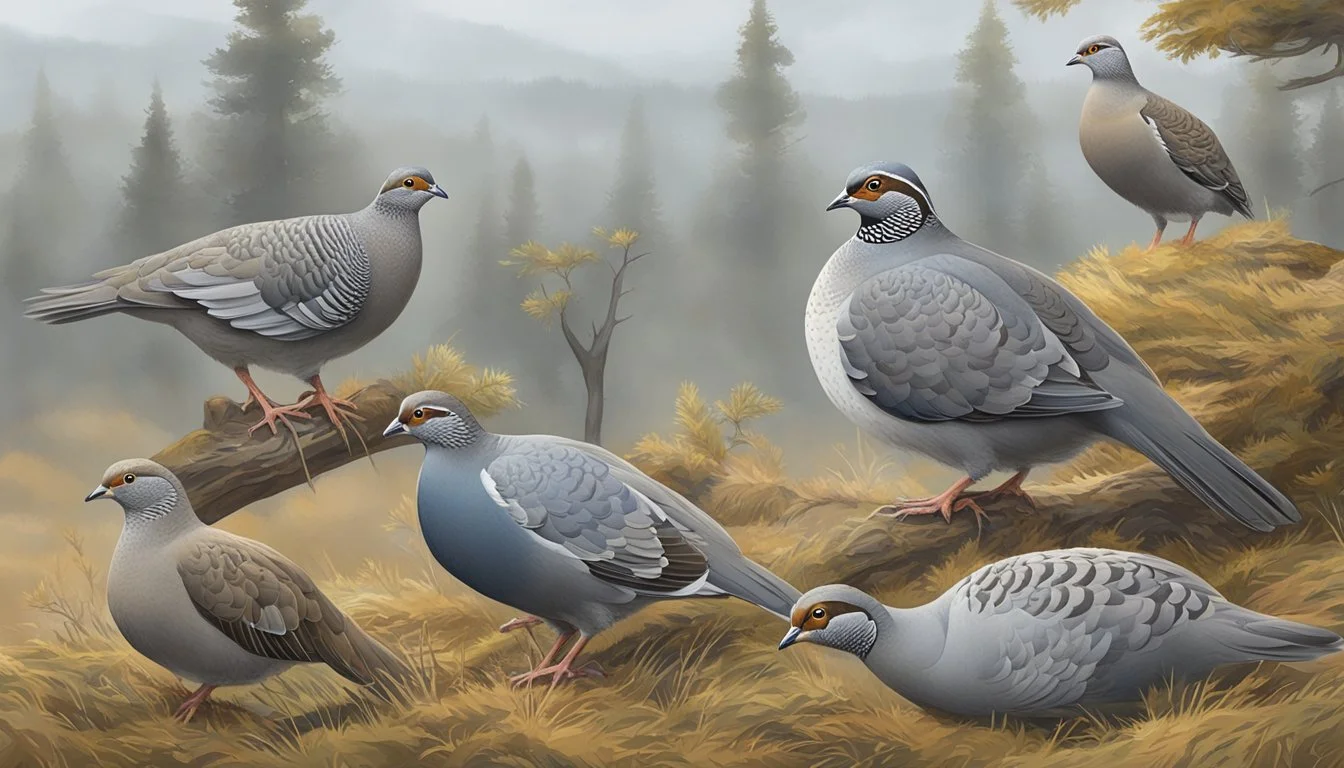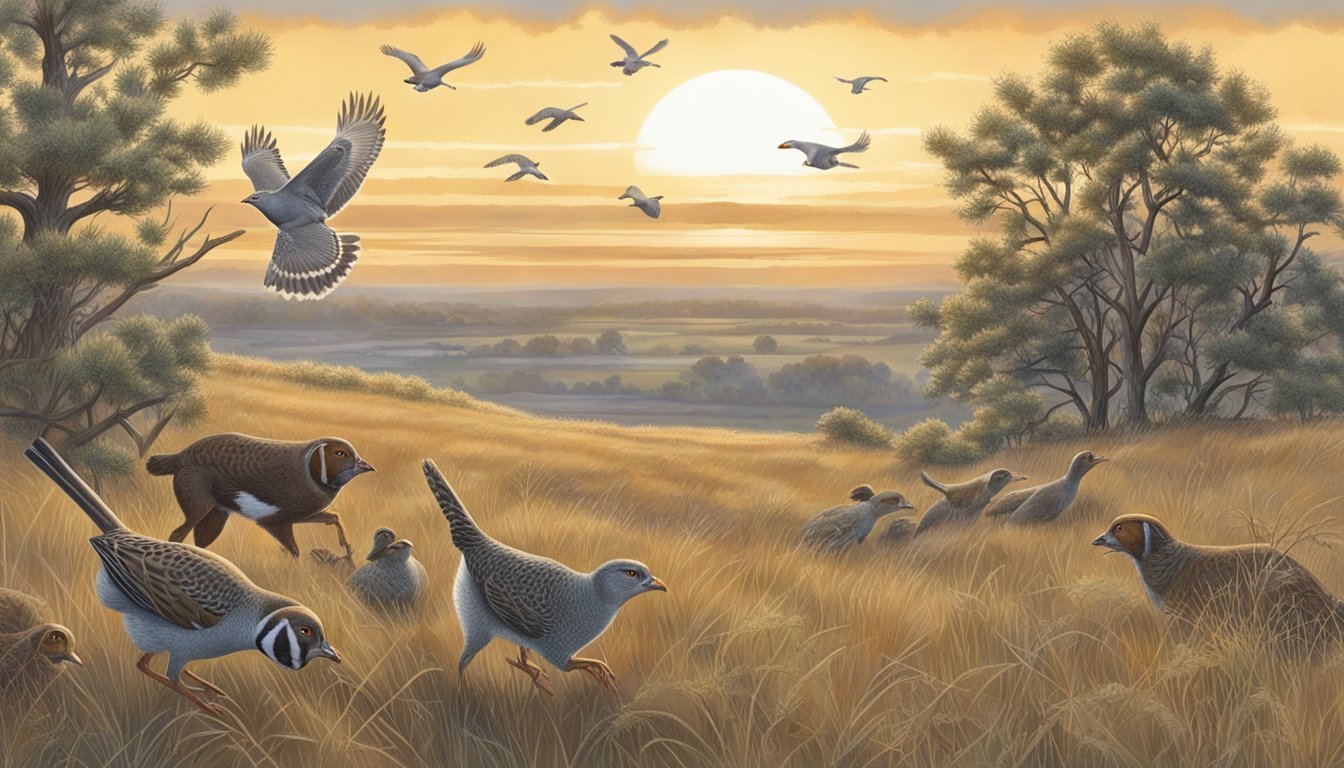Gray Partridge Hunting Seasons
Guidelines and Timelines
This Article is Part of Our Guide on Hunting Seasons for Over 70 Common Game Species
Gray partridge hunting offers enthusiasts an opportunity to engage with one of the most challenging yet rewarding forms of upland game hunting. Commonly referred to as the Hungarian partridge or simply 'Huns,' these birds inhabit a range of terrains, favoring farmlands, grasslands, and the edges of fields. They are known for their elusive nature and rapid, low flights, which can startle even the most seasoned hunters. With clutch sizes among the largest of game birds, including up to 22 eggs, the gray partridge's population is resilient, making it a viable target throughout the hunting season.
Seasonal regulations play a vital role in preserving the balance between sport and conservation for the gray partridge. Hunting seasons for these birds vary by location, often set by wildlife management authorities to align with the birds' breeding cycles and to ensure sustainable populations. Hunters are encouraged to familiarize themselves with local regulations, including the specific dates and any bag limits for the season, to responsibly partake in the tradition of hunting gray partridge.
The experience of hunting gray partridge is shaped by the terrain and the bird's behavior. As the season progresses, partridges become more skillful at evading hunters, often flying farther and more erratically upon subsequent flushes. This adaptability adds to the complexity and allure of pursuing gray partridge, challenging hunters to refine their strategies and heighten their awareness of the environment to outsmart this crafty game bird.
Gray Partridge Basics
In focusing on gray partridge, also known as Hungarian partridge or simply "huns," this section explores the bird's classification, preferred habitat, and distinguishing features.
Species Overview
The gray partridge (Perdix perdix), is a non-native upland game bird introduced from Europe. It has established populations in various regions of the U.S., where it is a popular target for hunting. Originating from Hungary and surrounding countries, these birds form social groups known as coveys, particularly outside of the breeding season.
Habitat and Distribution
Gray partridges favor farmland and open country interspersed with areas of tall vegetation for cover. In the U.S., they are found predominantly in the Great Plains states but are less abundant in comparison to other upland game bird species. Their preference for habitat includes:
Cultivated fields
Grasslands
Pasture lands
Physical Characteristics
Adult gray partridges are relatively small birds, typically weighing just under a pound and measuring around 12 inches in length. Key physical traits include:
Color: Grayish brown plumage with barred reddish-brown flanks
Face: A bold, dark orange face and throat
Tail: Rusty tail feathers
Belly: Both sexes sport a chestnut belly patch, with the female's patch being less pronounced
Their muted colors provide camouflage in their natural farmland habitats, assisting them in avoiding predators.
Preparation for Hunting
Before heading out for a gray partridge hunt, acquiring the right gear, obtaining the necessary licenses, training with hunting dogs, and understanding hunting techniques are crucial factors for a successful outing. Each of these elements plays a vital role in the hunting experience.
Required Gear
A hunter needs to equip themselves with the appropriate attire and equipment for gray partridge hunting. This typically includes:
Camouflage clothing: Helps blend with the environment.
Durable boots: Provides comfort during long treks.
Shotgun: Ideal gauge options include 12, 20, or 28.
Ammunition: No. 6 or 7.5 shot sizes are commonly used.
It's advisable to pack essentials like water, a first aid kit, and a means of communication for safety.
Hunting Licenses
Hunters are required to have a valid hunting license specific to the region where they intend to hunt. The process involves:
Researching rules: Each state has distinct regulations governing hunting seasons and licensing.
Application: Obtaining a hunting license usually requires completing an application and paying a fee.
Hunting Dogs
Hunting dogs significantly increase the chances of locating Huns. When involving dogs in a hunt, consider the following:
Training: Dogs should be well-trained to point and retrieve.
Health: A health check-up ensures the dog is fit for the hunt.
A proficient bird dog can lead a hunter directly to a flock, providing chances for a successful shoot.
Hunting Techniques
Employing effective techniques can maximize the hunting experience:
Walking up birds: Slowly walking through likely areas to flush out birds.
Flock shooting: Understanding the behavior of Huns, such as their tendency to fly in a certain pattern when flushed, can aid in predicting their flight path for more accurate shots.
Knowledge of these techniques, coupled with the correct gear and licensing, prepares a hunter for the challenging yet satisfying act of hunting gray partridges.
Hunting Seasons and Regions
Understanding the timing and location for hunting Gray Partridge is crucial for hunters aiming to optimize their outings. The seasons vary by region and are often timed to balance the species' life cycle and conservation with hunter demand.
Best Times to Hunt
Washington: The hunting season for Gray Partridge usually opens in late September and can run through January. The exact dates may change annually, so hunters should check with the Washington Department of Fish and Wildlife for the current year's season.
Idaho: Idaho offers a broad window for partridge hunting, typically beginning in September. Hunting can remain open until December or January, offering ample opportunity for those looking to pursue these birds in autumn and early winter.
Oregon: Similar to neighboring states, Oregon's seasons for Gray Partridge hunting start in September, giving hunters the chance to seek out these birds during the cooler fall months.
Geographic Hotspots
Idaho:
Snake River: Renowned for its robust populations, the Snake River region presents ample hunting grounds with suitable habitat.
Clearwater: This area also provides excellent opportunities for partridge hunters, with a mix of agricultural and wild lands.
Washington:
Columbia Basin: The open farmlands and wheat stubble provide an ideal habitat for these birds, making the Columbia region one of the better locations in Washington.
Oregon:
Upland Game Regions: Oregon's upland game areas typically feature terrains that Gray Partridge favor, such as grasslands and rolling hills where agriculture intersects with the wild.
Hunting Strategies
Successful gray partridge hunting requires an understanding of the bird’s behavior and the best methods for approaching them. Utilizing proper shot selection and field tactics can significantly increase a hunter's chances of a fruitful outing.
Approaching Coveys
When approaching coveys, hunters must exercise stealth and patience. Gray partridges are skittish and can be found in groups, especially in the West, where they are more prevalent. Hunters should approach with the wind in their face to mask their scent. It's crucial to move slowly and quietly as these birds are wary and may flush at any sign of danger.
Shot Selection
Full choke and improved cylinder chokes are effective for gray partridge hunting. The choice depends on the range and the hunter's comfort level with their firearm. A full choke is suitable for longer shots as it keeps the pellets together over a greater distance, while an improved cylinder is more forgiving and better for closer ranges. Always aim for the lower end of the rising bird, as gray partridges have a relatively long tail that can deceive hunters into shooting behind the bird.
Field Tactics
Employing intelligent field tactics is paramount in hunting gray partridges. The birds often prefer edge habitats, such as field borders, where they can feed and rest. Work these areas systematically, allowing gun dogs to flush the birds if they’re being used. Since partridges are skittish, be ready for sudden flushes:
Stay vigilant for quick takeoffs.
Positioning is key; try to walk through the most likely areas partridges use as cover.
Observe for any movements or signs on the ground, as partridges can blend into their surroundings.
Remember, patience and a strategic approach are essential to success in gray partridge hunting.
Conservation and Management
Effective management of the Gray Partridge populations is essential to ensure their sustainable presence across hunting landscapes. This involves not only regulating hunting seasons and bag limits but also a concerted effort in habitat preservation and understanding the species' breeding behaviors.
Population Control
The regulation of hunting seasons is a primary tool for the management of Gray Partridge populations. Authorities set specific hunting periods during times that are least likely to impact the birds' breeding cycles. Nesting typically happens in the spring, and clutches—ranging from 10 to 20 eggs—provide the next generation of birds. To prevent overhunting, daily bag limits are enforced, and harvesting is restricted to legal hunting hours from sunrise to sunset.
For example, during a given hunting season, the daily bag limit might be set at 8 gray partridges per hunter, and the regulation may codify that the possession limit cannot exceed 32 after the fourth day of the season. This approach helps maintain a balance in the bird's population, preventing abrupt declines due to predation, including human hunting, and natural factors.
Habitat Preservation
Gray Partridges thrive in diverse habitats, requiring a mosaic of farmland and open public land for their survival. The quality and availability of these habitats significantly affect their living conditions, influencing breeding success and resilience against predators.
Preservation efforts focus on maintaining appropriate vegetation that Gray Partridges use for nesting and protection. Public lands are particularly critical, as they often provide the necessary habitat conditions for the Gray Partridge:
Cultivated Fields: Partridges are often found adjacent to these areas, which provide both food and cover.
Grasslands and Shrublands: Dense vegetation is crucial for nesting, as it offers protection from predators.
Continual monitoring and collaboration between wildlife managers, hunters, and landowners help to implement relevant conservation practices. This can include planting cover crops, controlling pesticide usage, and setting aside conservation areas on both public and private lands. By maintaining these habitats, the Gray Partridge is supported not only during the hunting season but throughout its entire life cycle, thus fostering a stable environment for this upland game bird.
Understanding Game Behavior
Before hunters set out to pursue gray partridges, it is essential to understand the birds' feeding and reproductive behaviors and how these may influence their seasonal movements. This knowledge not only helps in locating the birds but also in ensuring a sustainable hunting practice.
Feeding Habits
Gray partridges primarily feed on a combination of seeds and insects, which dictates their presence in specific habitats. During the summer, their diet consists largely of insects which provide a rich protein source essential for growing chicks. As fall approaches, this diet gradually shifts towards a greater reliance on seeds. Hunters often find them in grain fields post-harvest, where waste grain provides a plentiful food supply.
Preferred grains include, but are not limited to:
Corn
Wheat
Reproduction Patterns
Gray partridges typically form monogamous pairs for the breeding season, which is relevant for hunters since the birds' territorial behavior during this time can predict their locations. Their nests are usually positioned on the ground, hidden among tall grasses to avoid predators. After mating, females lay a clutch of up to 20 eggs, with the chicks being precocial and able to leave the nest shortly after hatching.
Key nesting details:
Clutch size: Up to 20 eggs
Hatching period: Spring to early summer
Seasonal Movements
Unlike birds such as quail (What wine goes well with quail?), pheasants, and forest grouse, gray partridges do not typically engage in long migrations. However, they exhibit local movements in response to seasonal changes, such as moving from mountainous areas to more protected and resource-abundant lowland during winter. Knowledge of these movements can greatly affect hunters' success as partridges may move to agricultural edges or weedy cover, seeking shelter and food in colder months.
Winter habitats often include areas such as:
Edge habitats adjacent to fields
Shelterbelts
Grasslands
Legal and Ethical Considerations
Before heading out into the field, hunters should familiarize themselves with the legal requirements for gray partridge hunting, and the ethical considerations that ensure sustainable hunting practices. Adhering to regulations and respecting the principles of fair chase is crucial for maintaining hunting opportunities and managing hunting pressure on the bird populations.
Regulatory Compliance
Regulatory compliance is a pivotal aspect of gray partridge hunting. Each state sets its hunting seasons and bag limits to manage wildlife effectively. For instance, some areas may impose a strict daily bag limit to prevent overharvesting. Hunters must always check and adhere to the local rules, which may include specific restrictions on hunting near roadside areas to protect public safety and wildlife. Failure to comply with these rules not only risks legal repercussions but also threatens the balance of the ecosystem and future hunting opportunities.
Bag Limit: Hunters should confirm the legal harvest amount allowed, which can vary by region.
Daily Bag Limit: This is set to restrict the number of birds a hunter may legally take in a single day.
Seasonal Restrictions: Hunters must observe the designated hunting periods to avoid penalties.
Ethical Hunting Practices
In addition to following the law, hunters are expected to observe ethical hunting practices. This includes hunting in a manner that avoids unnecessary suffering of game and considering the impact of their activities on the environment. Ethical hunters also respect private properties and public lands, making sure their activities do not negatively affect the habitat or create excessive hunting pressure.
Fair Chase: Pursuing game in a manner that does not give the hunter an improper advantage.
Hunting Pressure: Managing the frequency and intensity of hunting to maintain healthy bird populations.
Respect for Wildlife: Ensuring that actions contribute to conservation efforts and respect the ecosystem.
Habitats and Ecosystem Impact
Gray partridges, typically found across European farmlands, are significantly influenced by agricultural practices and their habitats are crucial for their survival. The impact of hunting on these populations further intertwines with the ecosystems they inhabit.
Farmland Ecosystems
Gray partridges thrive in a diverse array of farmland ecosystems, particularly those that mix cultivated land with areas of brush, weeds, and grasslands. These birds are often associated with sagebrush habitats and the edges of roadsides and corn fields, where they can find both cover and food. Maintaining this habitat diversity is key for the gray partridge, which requires a mosaic of grasses and weeds for nesting and a supply of seeds and insects for feeding.
Brush and hedges provide nesting sites
Weeds and grasslands offer food resources and nesting material
Cultivated land, while providing food, can pose dangers if not managed properly
Effects of Hunting on Biodiversity
Hunting can have several impacts on gray partridge populations and the wider biodiversity of the farmland ecosystems. Sustainable hunting practices can actually benefit the ecosystem by:
Regulating partridge numbers: To maintain a balance within the ecosystem and prevent overpopulation.
Encouraging habitat conservation: Hunters often advocate for the preservation of natural habitats to ensure sustainable game resources.
However, unchecked or excessive hunting can lead to:
Declines in gray partridge populations, disrupting the food chain and ecosystem dynamics.
A reduction in seed dispersion that partridges contribute to, affecting plant diversity.
The interaction between hunting practices and habitat conservation is nuanced, and the sustainable management of both is essential for the health of farmland ecosystems.

